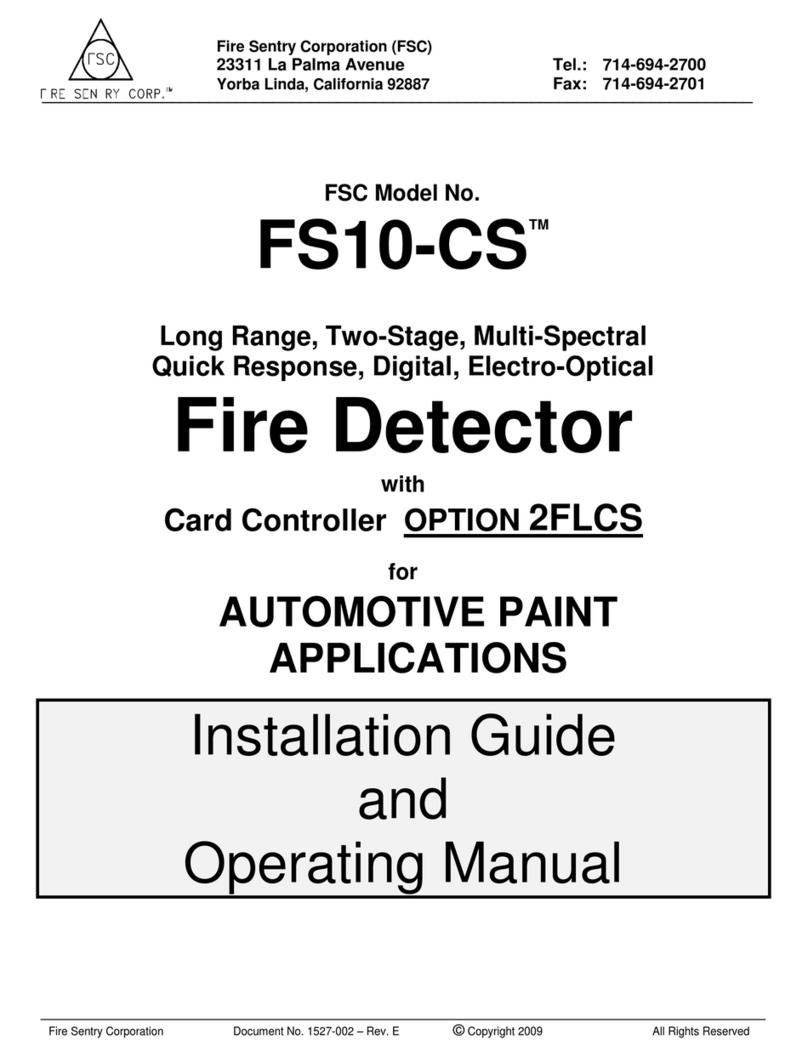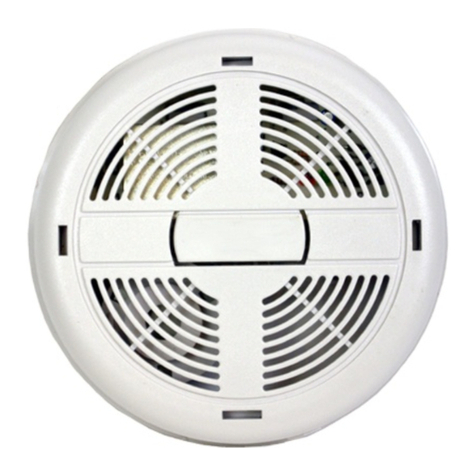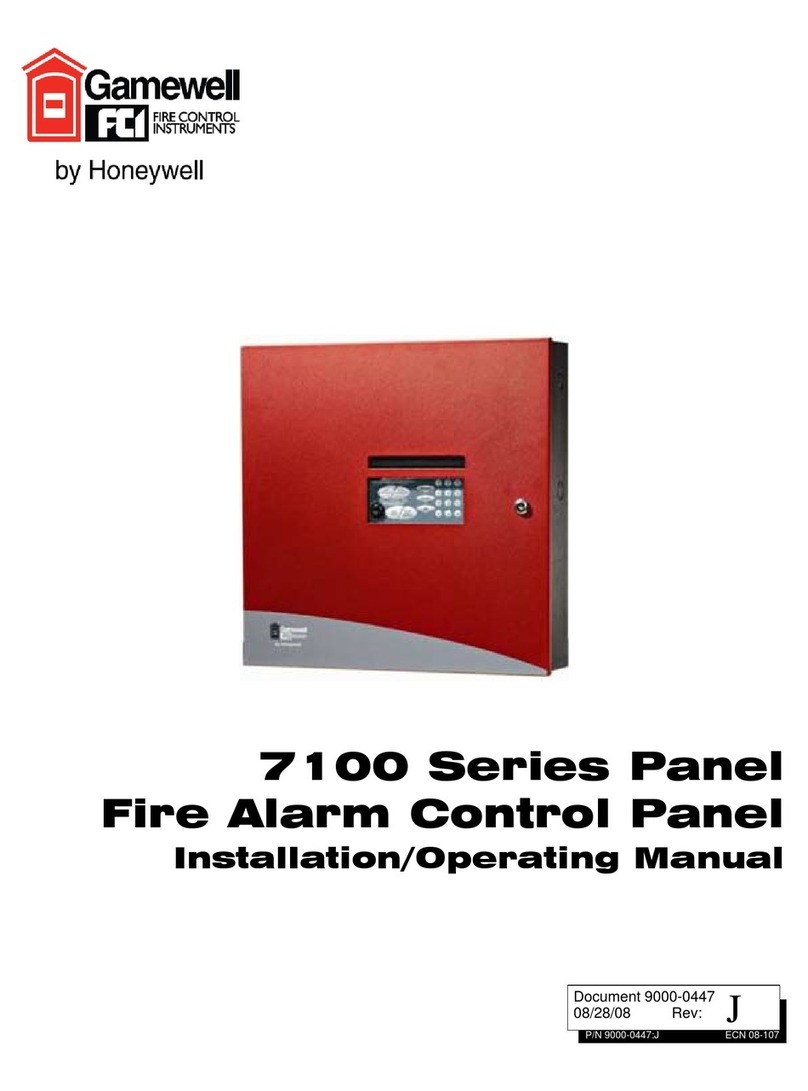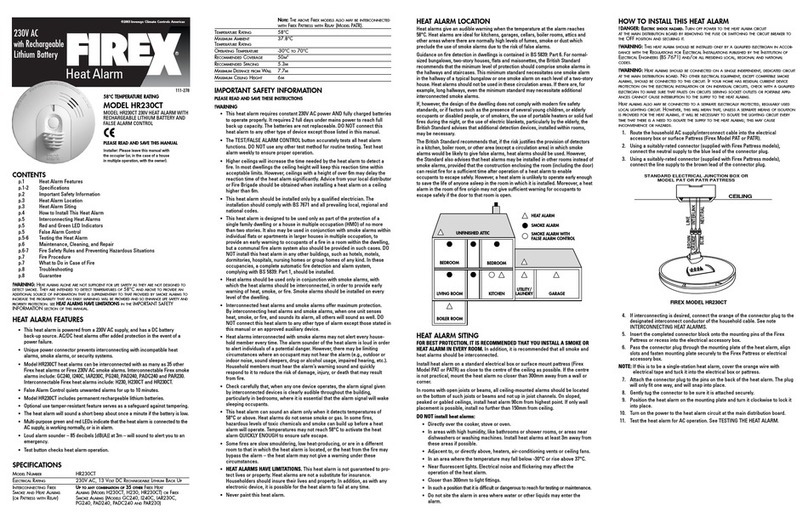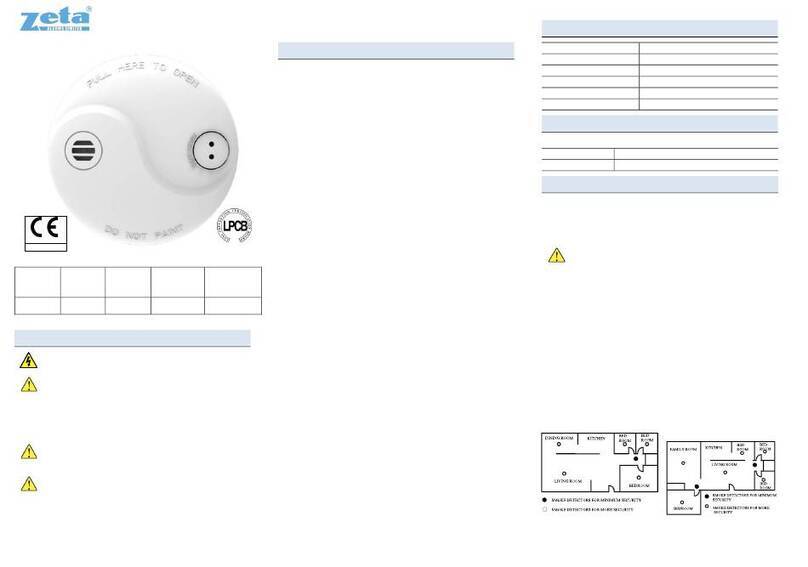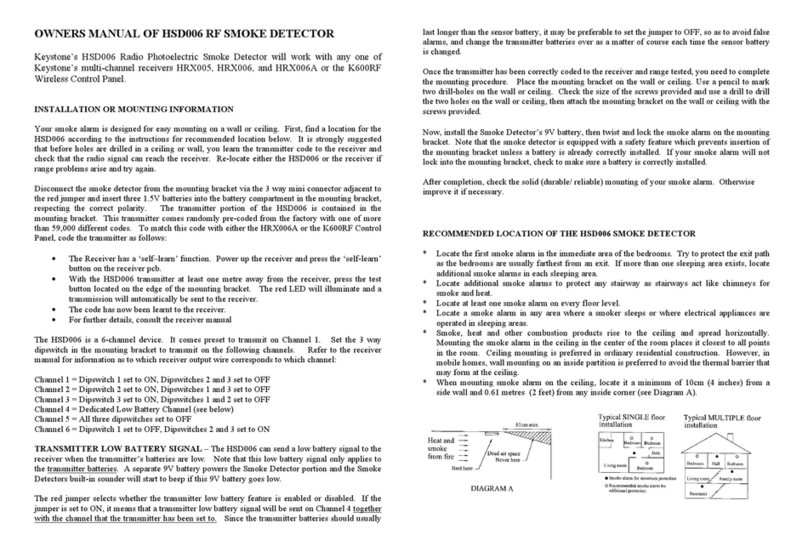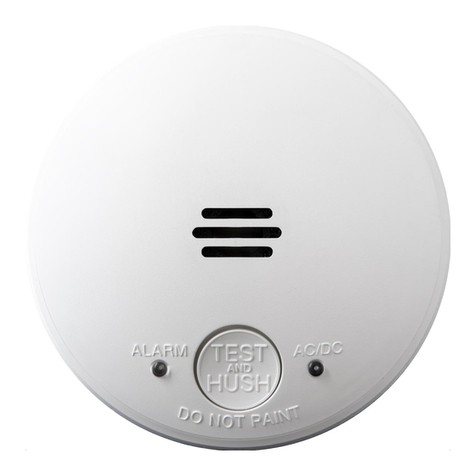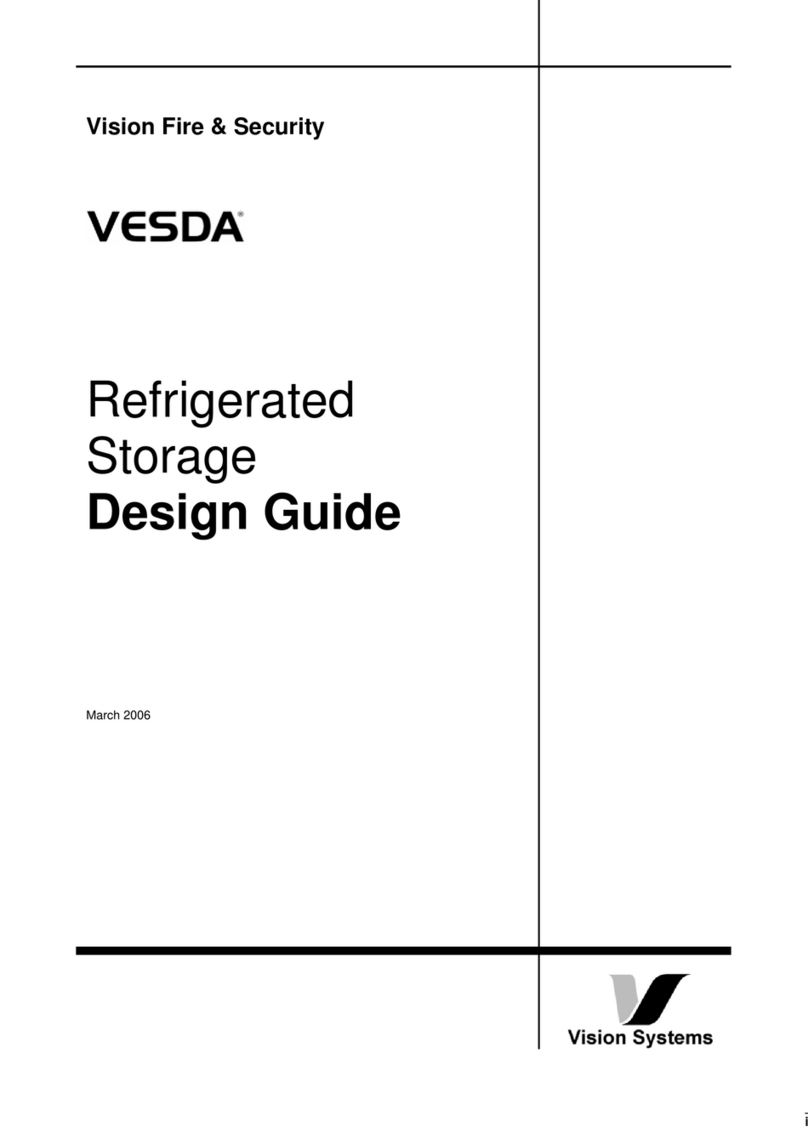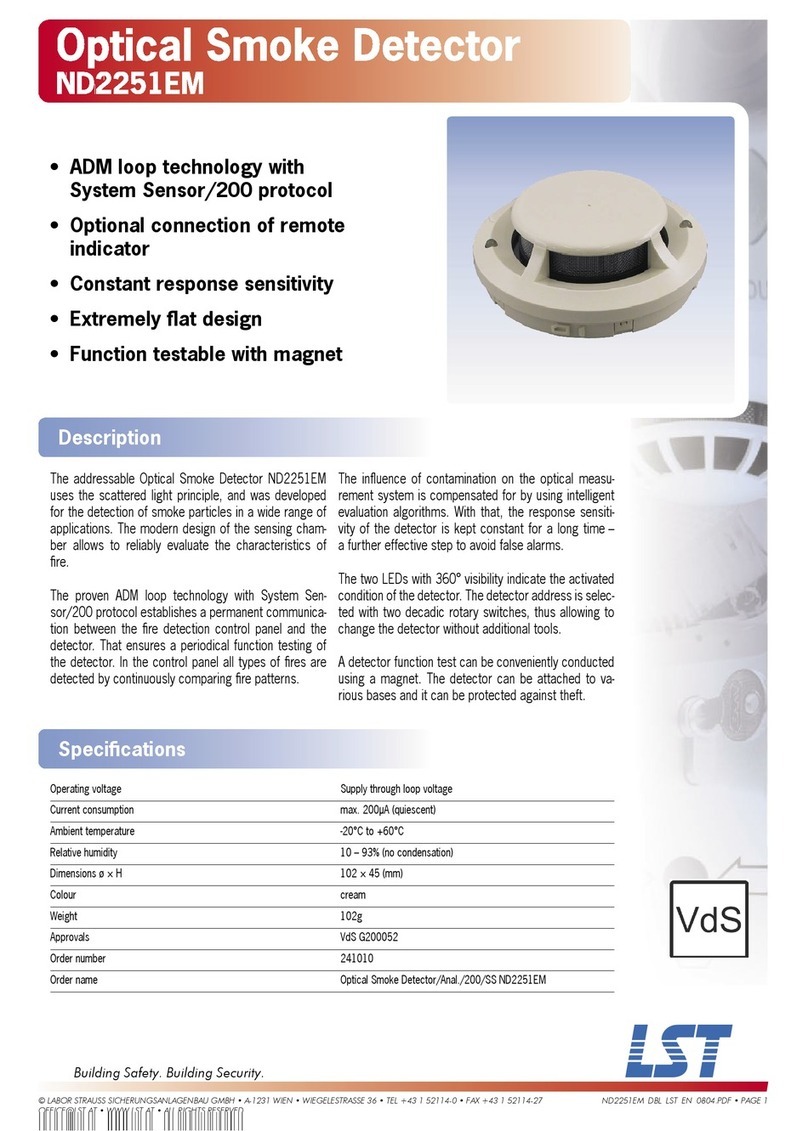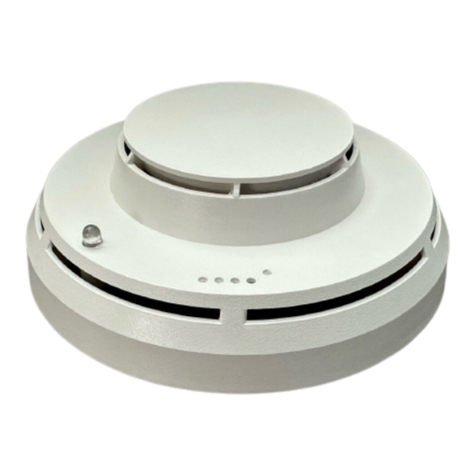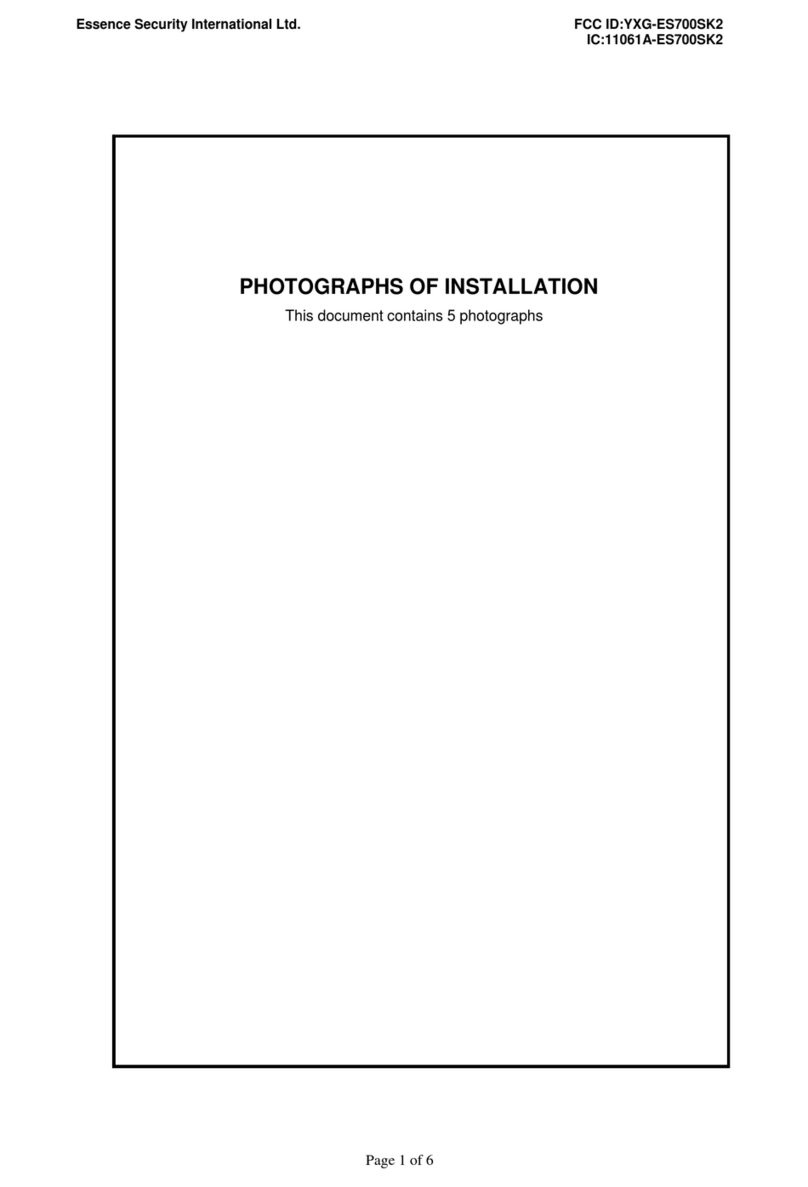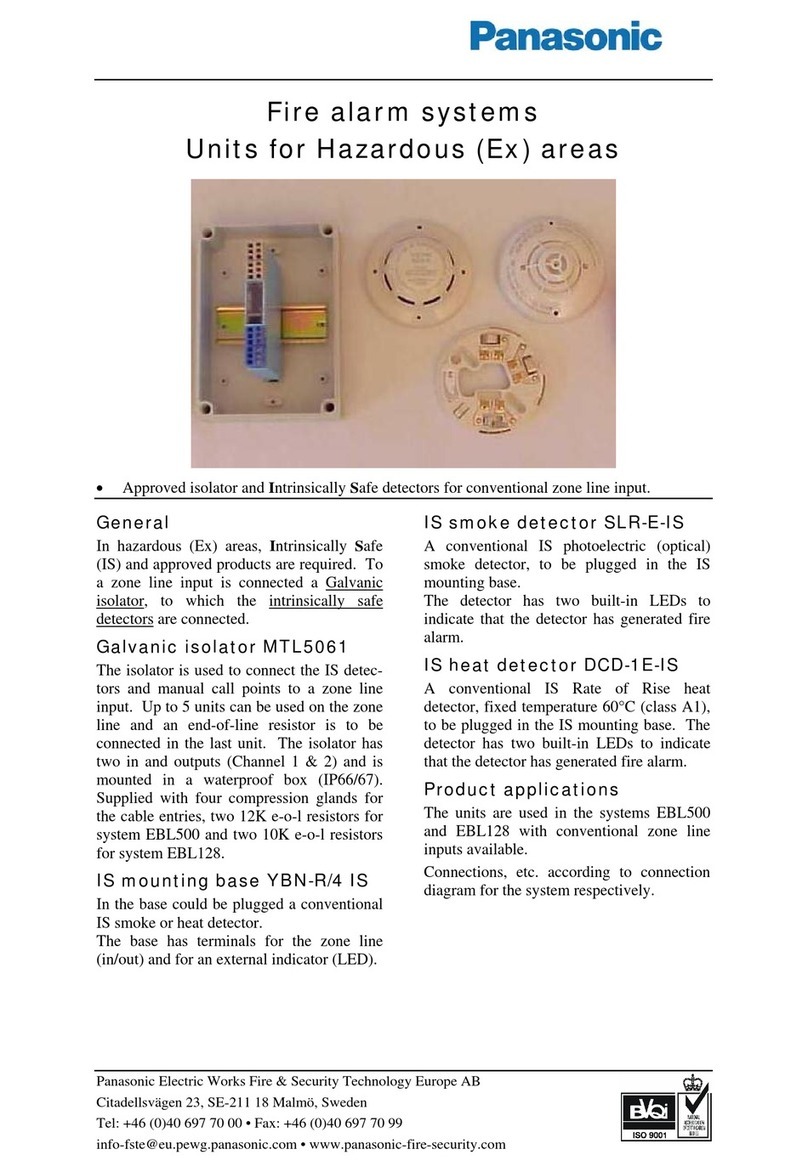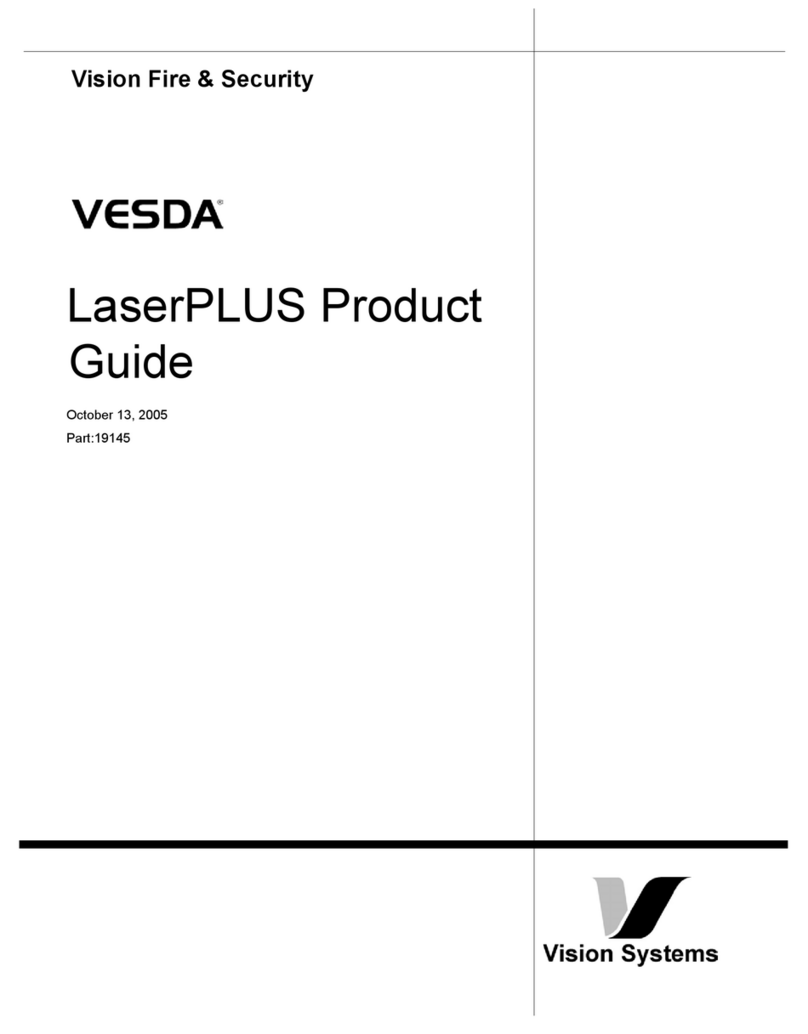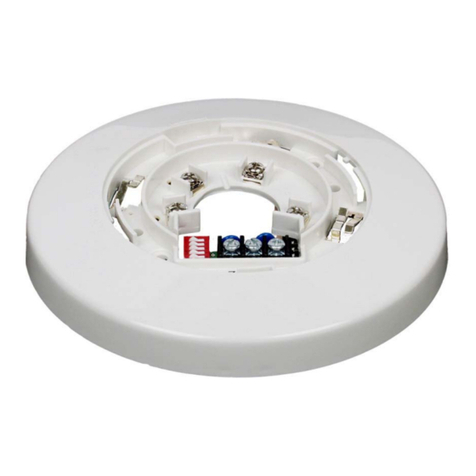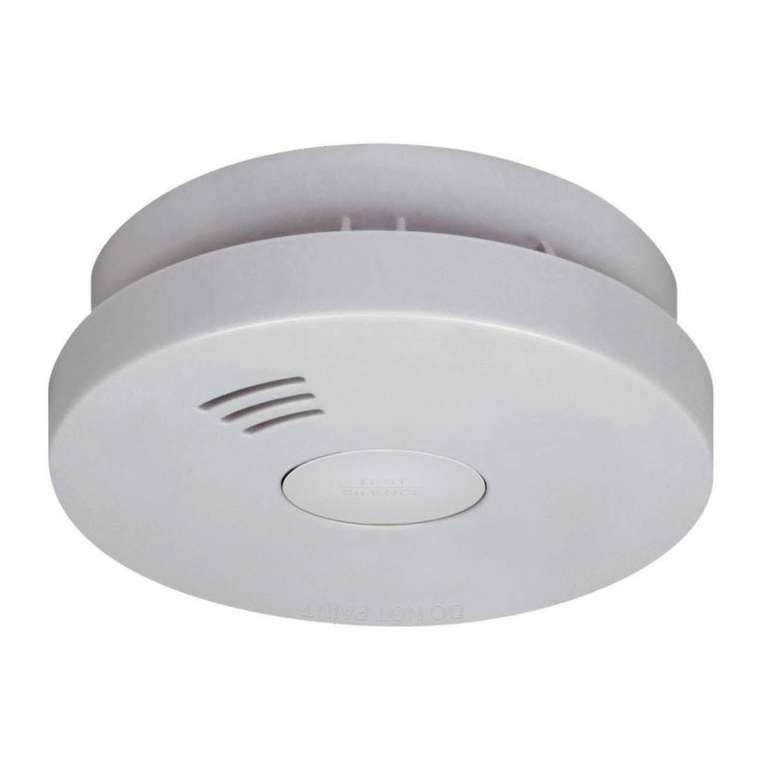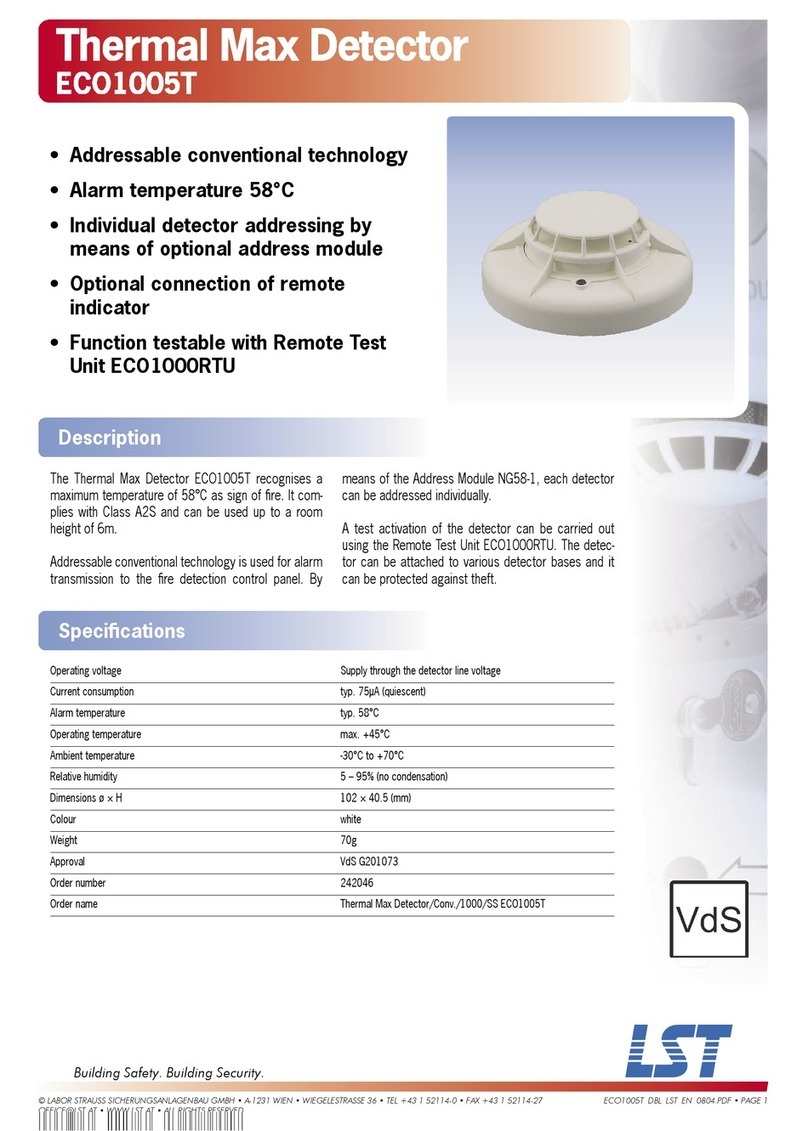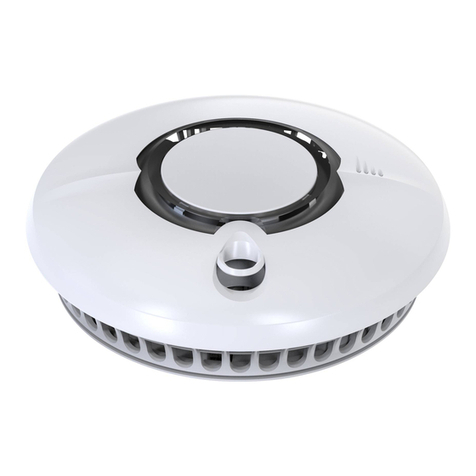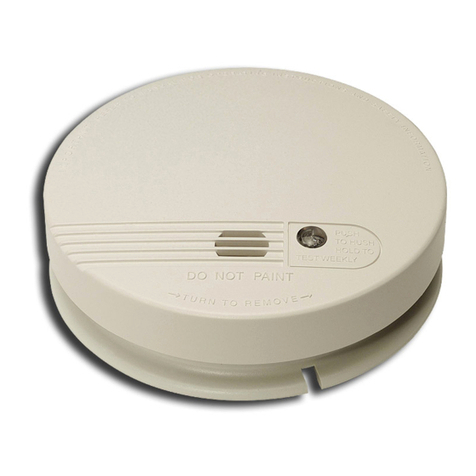Fire Sentry SS4-A Operating instructions

Model SS4-A/-A2 Optical Fire Detector Page i
Installation and Operations Guide
______________________________________________________________________________________________________________________
Fire Sentry Corporation Document No. 1510-007 –Rev D © Copyright 2009 All Rights Reserved
Multi-Spectrum Digital
Electro-Optical Fire Detector
MODEL
SS4-A/-A2
(CENELEC)
STAND-ALONE RELAY MODE
or 4-20 mA Output Option
Installation Guide
and
Operating Manual
Fire Sentry Corporation (FSC)
23311 La Palma Avenue Tel.: 714-694-2700
Yorba Linda, California 92887 Fax: 714-694-2701

Model SS4-A/-A2 Optical Fire Detector Page ii
Installation and Operations Guide
______________________________________________________________________________________________________________________
Fire Sentry Corporation Document No. 1510-007 –Rev D © Copyright 2009 All Rights Reserved
Fire Sentry Corporation (FSC)
23311 La Palma Avenue
Yorba Linda, California 92887
Tel: (714) 694-2700
Fax: (714) 694-2701
www.firesentry.com
Read and understand this manual before
installing or operating equipment.
No part of this document may be copied or reproduced without the express
written permission of Fire Sentry Corporation (FSC).
This manual is subject to change without notice.
ACCTTL, ALERT-1, ALARM-2, ALERT-1: ALARM 2, ALERT-1: ALARM-2, ATAG, Clean Room Sentry, COP-i,
Complete Optical Path Integrity, CM1, CM1-A, DartLogic, FireLogic, Fire Signature Analysis, FireBusI, FireBusII,
FirePic, FirePicII, FirePicIII, FirePix, FirePicture, FSC, Fire Sentry Corporation, Fire Sentry Corp., FSX, All FSX
Nomenclature Variations (such as: FS2, FS2X, FS3, FS3X, FS4, FS4X, FS5, FS5X, FS6, FS6X, FS7, FS7X, FS8,
FS8X, FS9, FS9X, FS10X, FS10X, FS11, FS11X, FS12, FS12X, FS14, FS14X, FS15, FS15X, FS16, FS16X, FS17,
FS17X FS18, FS18X, FS19, FS19X, FS20, FS20X, FS24, FS24X, FS24XN, FS26, FS26X, FS26XN), FS7-2173-2RP,
FS System 7, FS System 10, FS7-2173, FS7-2173-RP, FS2000, FS System 2000, High Speed Flame & Surveillance
Detector, Multi-Spectrum QuadBand Triple IR, Multi-Spectrum TriBand, Multi-Spectrum Tri-Band, Near Band Infrared,
Near Band IR, NearBand IR, QuadBand IR, Room Sentry, RS, RS2, SM2, SM3, SS, SS2, SS2X, SS2-A, SS3, SS3-A,
SS3X, SS4, SS4-A, SS4X, SnapShot, SLR-BIT, SuperBus, SuperSentry, System 2000, Tri-Mode Plot, QuadBand
Triple IR Plus, TriBand, Tri-Band, “FS & FSC triangle logo’s”, WBIR, Wide Band Infrared, WideBand IR, Wide Band IR
are Trademarks of Fire Sentry Corporation (FSC), Yorba Linda, California.
©Copyright 1998 - 2009 by Fire Sentry Corporation (FSC)

Model SS4-A/-A2 Optical Fire Detector Page iii
Installation and Operations Guide
______________________________________________________________________________________________________________________
Fire Sentry Corporation Document No. 1510-007 –Rev D © Copyright 2009 All Rights Reserved
TABLE OF CONTENTS
PAGE
APPROVALS.....................................................................................................................................................................1
SECTION 1 TECHNICAL DESCRIPTION ........................................................................................................................1
1.1Features and Specifications ................................................................................................................................1
1.1.1 General Description...................................................................................................................................1
1.1.2 Applications .............................................................................................................................................................2
1.1.3 Detector Locations..................................................................................................................................................2
1.2 Stand-Alone Operation.........................................................................................................................................2
1.3 FS2000 System Operation....................................................................................................................................2
1.4 Overview ................................................................................................................................................................3
1.4.1 Model SS4-A/-A2 Detector....................................................................................................................................3
1.4.2 Detection Range and Field-of View .....................................................................................................................3
1.5 Configuration Settings .........................................................................................................................................4
1.6 Testing....................................................................................................................................................................5
1.6.1 Special Conditions for Testing..............................................................................................................................5
1.6.2 Automatic Testing...................................................................................................................................................5
1.6.3 Manual Testing........................................................................................................................................................5
SECTION 2 INSTALLATION.............................................................................................................................................6
2.1 Installation Instructions........................................................................................................................................6
2.1.1 Installation Precautions..........................................................................................................................................6
2.1.2 Conduit Installation.................................................................................................................................................6
2.1.3 Wiring Recommendations .....................................................................................................................................6
2.1.4 Power Supply Considerations...............................................................................................................................6
2.2 Installation Procedure ..........................................................................................................................................6
2.2.1 Configuring and Wiring Detectors ........................................................................................................................6
2.2.2 Removing Detector From Its Enclosure. .............................................................................................................6
2.2.3 Configuring the Detector Module. ........................................................................................................................7
2.2.4 Wiring the Detector Module...................................................................................................................................7
2.2.5 Wiring the SS4-A/-A2 Detector for 4 to 20 mA Current Mode Operation (Optional) ....................................7
2.2.6 Wiring the Detector Relays....................................................................................................................................8
2.2.7 Replacing the Detector Module in the Enclosure...............................................................................................9
2.3 Enclosure Installation (optional) .........................................................................................................................9
SECTION 3 TROUBLESHOOTING AND MAINTENANCE............................................................................................12
3.1 Model SS4-A/-A2 Detector Faults......................................................................................................................12
3.2 Cleaning Windowed Enclosures and Detectors ..............................................................................................12
3.3 Personnel Training..............................................................................................................................................13
3.4 Detector Repair ...................................................................................................................................................13
DETECTOR PINOUT DATA............................................................................................................................................14
Verification Time.................................................................................................................................................................15
Latching................................................................................................................................................................................15
IR-Only Enable....................................................................................................................................................................15
Test Cycle............................................................................................................................................................................15
Fire Range...........................................................................................................................................................................15
SECTION 4 OPTIONAL ACCESSORIES.......................................................................................................................16
4.1 Air Shield for Applications in Contaminated Environment (Part No. DASA1-P)..........................................16
4.2 PC Software Kit (2029-INTERFACE-KIT)...........................................................................................................16
4.3 4-20 mA Option (MA420-4) .................................................................................................................................16
4.4 Detector Mounts (SM2 or SM4)..........................................................................................................................16
4.5 Test Lamp (FT-2045 or FT-2145)........................................................................................................................16
INDEX ..............................................................................................................................................................................17

Model SS4-A/-A2 Optical Fire Detector Page 1
Installation and Operations Guide
______________________________________________________________________________________________________________________
Fire Sentry Corporation Document No. 1510-007 –Rev D © Copyright 2009 All Rights Reserved
APPROVALS
The Model SS4-A and SS4-A2 (SS4-A/-A2) Optical Fire Detectors have been manufactured in compliance
with the requirements of the ISO-9002 standard and have received:
CENELEC approval by SIRA Certification Service in compliance with the ATEX Directive.
CE approval in compliance with the EMC Regulations.
SECTION 1: TECHNICAL DESCRIPTION
1.1 Features and Specifications
1.1.1 General Description
The Model SS4-A/-A2 Optical Fire/Flame Detectors are fast-reacting (within 5 seconds), digital, configurable,
computerized, “smart” units. This Detector has sensitivity to Type A, B, and C flaming fires. Detectors of this
design process Ultraviolet (UV), Wide band Infrared (IR), and Visible (VIS) spectral ranges from ruggedized
Solar-blind UV, “Quantum-Effect” IR, and visible sensors correspondingly. They are equipped with SRL-BIT
(Built-In-Test) for optical “through the lens” of both the sensors and lens. The Model SS4-A/-A2 UV, IR, and
VIS Fire Detectors have false alarm immunity, and adjustable alarm range between 15 and 60 feet for a one
square foot gasoline pan fire with a 120-degree (60 degrees from the axis) conical field of view. Their
microprocessor-based algorithms (FirePic, SnapShot, and Tri-Mode Plot) assure time programmable
alarm verification, Fire Signature Analysis, and compatibility with standard approved fire alarm panels.
The Detector also has the flexibility to be re-configured in the field. Its installation is simple, and operation
straightforward due to the built-in self-testing feature. Therefore, the maintenance consists mainly in keeping
the Detector window lens clean and performing periodic testing required by the manufacturer of the Fire
Control and Suppression System.
Other Specifications:
Housing: Explosion-Proof, Copper-free Aluminum (< 0.4%) with powder coated finish, or optional 316
Stainless Steel, NEMA type 3 and type 4 weatherproof, tamper-resistant with integral dual
¾ inch NPT conduit openings.
Marking: Class I, Div. 1 & 2, Groups B,C, & D
Class II, Div. 1 & 2, Groups E, F, & G
Class III
Temperature: Operation: -40 to +80C (-40 to +176º F)
Storage: -55 to 105C
Humidity range: 10% to 90% (RH), non-condensing
Weight: Aluminum housing is approximately 3.8 lbs. Stainless Steel is approximately 8.9 lbs.
Dimensions: 4.81 inches diameter by 4.40 inches high
LED Visual Indicators:
Powered Detector: Dual LEDs blink every 10 seconds
Fault Declared: One LED turns ON solid until the fault is cured
Re-calibrate when: Both LEDs flash ON and OFF rapidly
Fire Declared: Both LEDs ON solid (one LED blinks during first few seconds) and unlatches
after the fire threat is eliminated.

Model SS4-A/-A2 Optical Fire Detector Page 2
Installation and Operations Guide
______________________________________________________________________________________________________________________
Fire Sentry Corporation Document No. 1510-007 –Rev D © Copyright 2009 All Rights Reserved
Electrical Power Requirements:
Connectors: WECO type screw connectors, Wire: 18 to 24 AWG
Input Voltage range: 24 Volts DC nominal, 20.5 to 32 Volts DC
Normal Operation Current: 68 mA nominal (72 with optional MA420-4 Module)
Fire Alarm Current: 75 mA nominal (95 with optional MA420-4 Module)
Analog Current Output: 4 or 20 mA with optional MA420-4 Module.
Relay Contact:
Rating: 0.5 Amp at 120 Volt AC or 1 A at 24 V DC resistive
Fire relay: N.O. and N.C. contacts (Latching/Non-Latching, switch selected)
Verification relay: N.O. and N.C. contacts (Adjustable time from 0 to 30 seconds)
Fault relay: N.O. and N.C. contacts
1.1.2 Applications
Applications of the Model SS4-A/-A2 Detectors include warehouses, aircraft hangars, petrochemical facilities,
Silane gas storage, Gas turbines, and Power plants, among others.
1.1.3 Detector Locations
For unobstructed performance, considering Detector locations in application areas, avoid sources, other than
fire, which may cause false alarms, such as operations utilizing welding or gas torch equipment, high power
sources of EMI or RFI, or artificial lighting pointed directly at the Detector. Locations experiencing strong
mechanical or acoustical vibrations should also be avoided. For optimum performance, locate the Detector(s)
as close as possible to the potential fire source, preferably, along the axis of the vision cone. Install enough
Detectors to completely eclipse the fire hazardous area. Assure accessibility for the Detector lens cleaning, as
well as best possible protection and/or cleaning from fog, rain, ice, dust, hazardous atmospheres, and other
adverse elements. If necessary, utilize the Steel Swivel Mount (Model SM2) or 316 Stainless Steel Swivel
Mount (Model SM4) for greater flexibility in mounting locations (See Figures 4 and 5).
1.2 Stand-Alone Operation
For Stand-Alone operation, the Model SS4-A/-A2 Detector may be connected to a FM Approved or UL listed
Fire/Security Panel. The Detector operated in the Stand-Alone mode uses the Fire, Fault, and Verify (optional)
relays to interface to the Fire/Security Panels. For Stand-Alone operation, the Detector’s Fault relay is
automatically configured by the on-board microprocessor. The input current of the Model SS4-A/-A2
Detector is about 15 mA higher in the Stand-Alone mode compared to FS2000 System operation.
NOTE: The Fault relay is not available when the Detector is wired to the FS2000 System.
1.3 FS2000 System Operation
For FS2000 System operation, the Detector Fire and Fault signals are sent digitally to the FS2000 System
Controller using the four wire FS2000 FireBus. The FireBus provides the 24 volts DC power for the Detector
and RS-485 digital communication (Refer to Fire Sentry document MN0003 entitled "FS2000 FIRE EARLY
WARNING SYSTEM - INSTALLATION and OPERATIONS GUIDE"). For special remote alarm applications,
users may also connect directly to the Detector’s Fire alarm relay.
NOTE: When the Model SS4-A/-A2 Detector is connected to the FS2000 System using FireBus
communication, the Controller automatically disables the Detector’s Fault relay.

Model SS4-A/-A2 Optical Fire Detector Page 3
Installation and Operations Guide
______________________________________________________________________________________________________________________
Fire Sentry Corporation Document No. 1510-007 –Rev D © Copyright 2009 All Rights Reserved
1.4 Overview
1.4.1 Model SS4-A/-A2 Detector
Version SS4-A: There are two (2) LEDs on the Model SS4-A Detector that indicate the state of the Detector.
During normal operation both LEDs will blink every 10 seconds.
If the Detector alarms to a fire, it energizes the Fire relay and turns on both LEDs in the following sequence.
One LED is turned on immediately and the second LED will rapidly blink for several seconds indicating that the
Detector's FirePic spectra is being permanently stored in the Detector's solid-state memory (FirePic is the
several seconds of Detector spectral data which precedes an alarm event). Once the FirePic data is stored,
the second LED will remain on. For this version, the fire alarm LEDs turn on and remain on until power to the
unit is cycled (turned off and on again).
If a the Detector has a Fault, it de-energizes the Fault relay and turns one (1) LED on (the LED will not light if
the Fault is a “No Power Fault”). If the Fault condition, such as a “Low Voltage Fault”, is eliminated the
Detector will automatically return to Normal Operation.
NOTE: Faults caused by excessive input voltage or due to temperatures outside the operating temperature
range require factory re-certification. Re-certification is required if a Fault is indicated by both LEDs rapidly
blinking (with frequency about 2 Hz.).
Version SS4-A2: The operation of this unit is identical to the SS4-A, except the fire alarm LEDs turn off once
the fire threat is eliminated, without power cycling of the device.
1.4.2 Detection Range and Field-of View
The SS4-A/-A2 detection range is field adjustable between 15 and 60 feet in 15 feet increments to an industrial
standard of one square foot Gasoline, Kerosene, or isopropyl Alcohol pan fire within 5 seconds.
The Detector is also optimized for the following specific type of fuels and will alarm to the resultant fire within
five (5) seconds. Careful attention should be given to the Detector sensitivity setting for these types of fires.
Silane Gas: 10” (10-inch) fire height using a 3/16” orifice at a 15-foot distance, with the Detector
sensitivity setting of 15 feet.
Propane Gas: 10” (10-inch) fire height using a 3/8” orifice at a 15-foot distance, with the Detector
sensitivity setting of 15 feet.
Jet fuel-A: ONE square foot pan fire at a 60-foot distance, with the Detector sensitivity setting of 60
feet.
JP-5: ONE square foot pan fire at a 60-foot distance, with the Detector sensitivity setting of 60 feet.
JP-4: TWO square foot pan fire at a 100-foot distance, with the Detector sensitivity setting of 60 feet.
JP-8: TWO square foot pan fire at a 100-foot distance, with the Detector sensitivity setting of 60 feet.
The Detector incorporates a 120-degree conical Field of View. The fire emissions received by the Detector
diminish at extreme range and edges of the field-of-view. It is recommended that the Detector be pointed at
the fire threat area for the fastest response times to the smallest size fire. When multiple Detectors are used to
cover large areas, the Field-of-Views should overlap to insure complete coverage of the fire threat area. The
Field-of-View is not, however, limited to 120 degrees. Larger fires outside the 120 degree Field-of-View may
cause the SS4-A/-A2 to alarm. This is based on the Inversed Square Law for radiated energy, a larger size
fire outside the Detection Range and field-of-view may cause the Detector to alarm. Refer to Figure 1.

Model SS4-A/-A2 Optical Fire Detector Page 4
Installation and Operations Guide
______________________________________________________________________________________________________________________
Fire Sentry Corporation Document No. 1510-007 –Rev D © Copyright 2009 All Rights Reserved
120 Degrees
Figure 1: Field of View, Horizontal, and Vertical.
Sensitivity to 1 Sq. Ft. Gasoline Pan Fire
1.5 Configuration Settings
The SS4-A/-A2 Detector may be reconfigured in the field and thus optimized for special applications. The
configuration of the Detector is set using DIP switches located on the middle circuit board of the Detector
Module. The DIP switch settings for each configuration are listed in Table 2.
These configurable options include:
1. Fire Verify Relay - The Verify Relay may be disabled or enabled with several Verify Time settings. It also
may be set to act as another Fire Relay. The Verify Time may be set from 5 to 30 seconds in 5 seconds
increments. The Factory setting: Verify Relay Disabled.
When the Verify Relay is enabled and Verify Time is set the Verify Relay will energize and the Fire Relay will
de-energize if the fire conditions are still present at the end of the Verify Time period. In the opposite case,
the Detector will wait for 5 seconds plus another Verify Time period to test for the fire conditions. This wait
and verify cycle will repeat 10 times, or until the presence of the fire is confirmed. This concludes the
verification process. If the presence of the fire is not established the Fire Relay will remain energized unless
Non-Latching mode is set. In case a subsequent fire is detected the entire verification process will be
repeated. The state of the Fire and Verify Relay after the verification process will depend on the choice
between Latching and Non-Latching modes.
NOTE: When the Verify Relay is enabled and Verify Time is set, the Fire Relay will de-energize when
the Verify Relay is energized.
2. Latching / Non-Latching - The Fire Relay and Verify Relay may be set in a Latching or Non-Latching mode.
If Latching mode is selected on the SS4-A, the Fire or Verify Relay and red LEDs will remain energized until
the Detector power is cycled (power is turned off then on). If Latching mode is selected on the SS4-A2, the
Fire or Verify Relay will remain energized until the Detector power is cycled (power is turned off then on), but
the red LEDs will reset once the fire threat is eliminated. The Factory setting is Latching.
If Non-Latching mode is selected the Fire Relay and red LEDs will reset after 10 seconds. Non-Latching
mode may not meet some Fire Codes. Consult with authority having jurisdiction over the area of application
before using this setting.
3. Test Period - This setting pertains to the Through-the-Lens test period, which may be set to 6 or to 30
minutes. The Factory setting is 30 minutes. The 6-minute period may be required in applications where the
lens is frequently obscured.
NOTE: Utilization of the 6-minute period may adversely affect the source tube service life.
4. IR-Only Enable / Disable

Model SS4-A/-A2 Optical Fire Detector Page 5
Installation and Operations Guide
______________________________________________________________________________________________________________________
Fire Sentry Corporation Document No. 1510-007 –Rev D © Copyright 2009 All Rights Reserved
The IR-only setting allows the Detector to declare a Fire on events where UV is not present or is obscured. In
applications where UV absorbing fumes are commonly present in high concentrations (these fumes are
usually toxic and should require masks or breathing equipment), the Detector will function. The Factory
setting for IR-Only is Disabled.
WARNING: IR-only setting should be used only in special indoor applications.
5. Fire Detection Range Setting - 15, 30, 45, or 60 feet. The Factory setting is 45 feet. This setting should be
changed only if the Detector is located too close to the fire threat area and in the presence of abnormally high
UV.
1.6 Testing
1.6.1 Special Conditions for Testing
The SS4 Detector should be tested immediately after installation, after repair or maintenance involving
wiring or module replacement, after periodic maintenance, or after lens contamination has been
identified.
1.6.2 Automatic Testing
Automatic SLR-BIT (Built In Test) “through-the-lens” self-testing is performed for virtually all-internal
electronic systems of the Detector every 10 minutes during its operation. The Detector’s red LEDs
blinking 3 times in rapid succession indicates window lens contamination, or lack of the protective grill or
enclosure cover.
1.6.3 Manual Testing
For manual testing, the SS4-AUV Detector may be exposed to an actual industry standard open flame or
to a Test Lamp simulating a fire. It is mandatory to use the Fire Sentry handheld UV/IR Test Lamp Model
No FT-2045 or FT-2145 with SS4 Fire Detectors. The FT-2045 and FT-2145 Test Lamps are housed in
an Explosion-Proof enclosure, powered by internal rechargeable batteries, and designed for indoor and
outdoor use. For additional information on the Test Lamps, refer to FSC Specification SP0242 for FT-
2045 or 1505-008A for FT-2145.
NOTE: Other manufacturers UV/IR Test Lamps should not be utilized to test FSC Detectors,
conversely, the FT-2045 and FT-2145 Test Lamps should not be utilized for testing other manufacturer’s
Detectors.

Model SS4-A/-A2 Optical Fire Detector Page 6
Installation and Operations Guide
______________________________________________________________________________________________________________________
Fire Sentry Corporation Document No. 1510-007 –Rev D © Copyright 2009 All Rights Reserved
SECTION 2: INSTALLATION
2.1 Installation Instructions
This section describes the installation of the Model SS4-A/-A2 Detector for the Stand-Alone relay mode. It is
recommended that junction boxes be used to wire the Detectors. Determine the configuration settings for the
device(s) and the number of connections to be used (Fire, Fire Verify, Fault, and Power) depending on the
desired Detection Range and the Fire Control Panel type used (refer to the Fire Control Panel Manual for
details).
2.1.1 Installation Precautions
The following precautions should be observed during installation of Model SS4-A/-A2 Detectors.
1. Make sure that the external electrical power is turned OFF before connecting the Detector.
2. Printed circuit board components of the Detector are susceptible to damage from electrostatic
discharge. Do not handle the Detector's module (and its printed circuit boards) without adequate
grounding and observing all necessary measures to prevent the effect of electrostatic discharge
(ESD).
2.1.2 Conduit Installation
When planning the conduit, follow these recommendations.
1. If only one of the two 3/4 inch NPT conduit openings on the Model SS4-A/-A2 Detector enclosure is
used, seal the unused opening with a threaded plug and approved sealing material.
2. In areas where moisture may accumulate, install an approved conduit trap or drain.
3. A seal should be installed at the enclosure wall for all applications requiring a Class I, Div. 1
Explosion-Proof rating.
2.1.3 Wiring Recommendations
To prevent intermittent connections, Fire Sentry Corporation recommends using junction boxes. Install a
junction box near each Detector location. Wire each Detector to its junction box. Use screw-down terminal
strips inside the junction box to make the connections from the Detector's terminals to an FM Approved or UL
listed Fire Alarm Panel. Also use FM/UL Approved junction boxes and terminal strips.
NOTE: Avoid wire splices. However, if wire splices are necessary, all splices should be soldered.
Utilization of good wiring practices will simplify installation, improve reliability, and facilitate maintenance.
2.1.4 Power Supply Considerations
The Model SS4-A/-A2 Detector uses 24 Volts DC at a maximum current of 75 mA (with the 4-20 mA option the
maximum supply current is 95 mA). Make sure the Panel's power supply can withstand the load current of the
total number of Detectors connected to it. For example, if 10 (ten) Model SS4-A/-A2 Detectors are connected
to a single Panel's power supply (multiplying 75 mA by 10), the power supply must be able to withstand at
least 750 mA + 10% (0.75 A + 10%). This load current must also be taken in consideration for calculating the
Panel's 24-hour power backup requirements.
2.2 Installation Procedure
2.2.1 Configuring and Wiring Detectors
To configure and wire a Model SS4-A/-A2 Detector, or to replace the Detector module, the module must be
removed from the enclosure. After the configuration settings and wiring connections have been completed,
the module should soon be re-installed in the enclosure to avoid contamination from the environment.
NOTE: Avoid touching the Detector sensors at the front of the Detector module. If touched accidentally,
they should be cleaned per instructions of Section 3.2.
2.2.2 Removing Detector From Its Enclosure.

Model SS4-A/-A2 Optical Fire Detector Page 7
Installation and Operations Guide
______________________________________________________________________________________________________________________
Fire Sentry Corporation Document No. 1510-007 –Rev D © Copyright 2009 All Rights Reserved
a. With electrical power off (verify that electrical power is off by making sure that the Detector's LEDs
do not blink for at least 15 seconds), loosen the Allen-head screw at the base of the metal
enclosure top lens cover.
b. Remove the cover and set it aside along with the "O" ring avoiding contamination.
c. Loosen the three Philips head captive screws located on the top circuit board.
d. Carefully lift out the module, sliding it along the three metal standoffs.
2.2.3 Configuring the Detector Module.
Set the DIP switches located on the center PC board of the Detector module to desired settings.
Refer to Section 1.5 and Table 2 for DIP switch settings.
2.2.4 Wiring the Detector Module.
a. Insert the cables into the metal enclosure base through one of the conduit openings. Refer to
Figure 6.
b. Connect the 24 Volt DC power supply wires to pins 1 (-) and 4 (+) of the J1 or J2 connector,
observing the correct polarity. Refer to Figure 2. Firmly tighten down the two slotted screws with a
small screwdriver taking care not to over-tighten the screws.
Pins 2 and 3 of the J1 and J2 connectors are the RS-485 interface used only for downloading the
FirePic from the Detector’s non-volatile memory, or for viewing the Tri-Mode Plot. It is recommended
to wire pins 2 and 3 to a separate junction box and properly identify them for future use. A color-
coded, multi-connector, shielded, UL-rated cable with 18 to 24-gauge wire is recommended for
connecting to J1 or J2. The following color-coding is suggested as a guideline:
Pin 1 Pin 2 Pin 3 Pin 4
Black Green or Blue White or Yellow Red
GROUND (-) RS-485(-) RS-485(+) POWER (+)
*Fault Relay
Verify
Relay
* Fault relay is shown in the energized condition during normal operation (No Fault).
Figure 2: Model SS4-A/-A2 Detector Wiring
(Bottom View of SS4-A/-A2 Detector Module)
2.2.5 Wiring the SS4-A/-A2 Detector for 4 to 20 mA Current Mode Operation (Optional)

Model SS4-A/-A2 Optical Fire Detector Page 8
Installation and Operations Guide
______________________________________________________________________________________________________________________
Fire Sentry Corporation Document No. 1510-007 –Rev D © Copyright 2009 All Rights Reserved
For applications requiring a 4-20 mA analog output, order the optional 4-20 mA Module
Assembly, P/N MA420-4, separately or included with the SS4-A/-A2 Detector.
The following analog output levels are available from Detector equipped with the MA420-4 Module:
NORMAL Operation 4 +/- 0.6 mA
ALARM 20 +/- 0.6 mA
FAULT < 0.6 mA
To use the analog output of an SS4-A/-A2, make the following connections:
24 V DC J2, pin-4
24 V DC RTN J2, pin-1
4-20 mA output J5, pin-4 (+)
4-20 mA RTN J1, pin-1 (-)
The fire Alarm and fault relays of a Detector equipped with the MA420-4 Module are not usable.
However the Detector’s Verify Relay may still be used as a separate Fire Alarm output. Refer to Table
2: “Configuration DIP Switch Settings” to set DIP switches properly.
NOTE: J1 is a "loop through" connection to J2. The +24 V supply is connected to J2 pin 4. The red
lead connection of the MA420-4 must stay in J1, pin-4. Also, the 8.66 K Ohm supervising
resistor (included with each module) must be connected at the Fire Alarm relay contacts J4
pin-4 to J4 pin-1, or a Fault condition will occur.
Figure 3: SS4 Detector Module with MA420-4 Installed
(Rear View)
2.2.6 Wiring the Detector Relays
a. Insert relay cables into the Detector enclosure base through one of the conduit openings. Refer to
Figure 6.

Model SS4-A/-A2 Optical Fire Detector Page 9
Installation and Operations Guide
______________________________________________________________________________________________________________________
Fire Sentry Corporation Document No. 1510-007 –Rev D © Copyright 2009 All Rights Reserved
b. Fire Alarm Relay - Connect wires for Fire Alarm to the appropriate J4 terminals of the Detector.
For Normally Open relay contacts, install wires into pins 3 and 4 and firmly tighten down the
slotted screws with a small screwdriver. The Fire Alarm relay is de-energized during normal
operation and will energize when detecting a fire.
c. Fault Relay –Connect wires for Fault to the appropriate terminals of the J5 connector. For
Normally Closed relay contacts, install wires into pins 3 and 4 and firmly tighten down the slotted
screws with a small screwdriver. The fault relay is energized during normal operation and with no
fault detected, as shown in Figure 2. The fault relay will de-energize when a fault is detected.
2.2.7 Replacing the Detector Module in the Enclosure.
a. Carefully re-install the module over the three metal standoffs and screw it down with the three
captive screws to the standoffs.
b. If necessary, clean the Detector’ sensors and windowed cover per instructions of Section 3.2.
c. Securely screw down the metal enclosure top windowed cover and tighten the Allen-head
"tamper-proof" screw.
2.3 Enclosure Installation (optional)
2.3.1 Installing the Detector on the Swivel Mount (SM2) or SS Extra Duty (SM4) Swivel Mount
a. Select fasteners for the swivel mounting such that they will secure it to the type of material at the
enclosure location.
b. Mount the swivel-mount to the wall assuring correct orientation.
c. Install the mounting bracket onto the Model SS4-A/-A2 Detector enclosure using the #¼-20 or #6
mm screws and nuts provided. If oriented correctly, the outside contours of the mounting ears on
the Detector enclosure and the ends of the bracket will match. The large diameter of the threaded
insert should face the enclosure.
d. Screw the enclosure/bracket assembly onto the ball or swivel stud. Turn the Detector until the stud
bottoms against the enclosure. Do not tighten. While holding the enclosure, tighten the jam nut
against the bracket.
e. While holding the enclosure, loosen the socket head screw on the SM2 swivel-mount or swivel
release bolt on the SM4. Position the enclosure in such a way that the conduit openings are
located horizontally at the bottom. Point the enclosure in the desired direction and tighten the
appropriate hardware.

Model SS4-A/-A2 Optical Fire Detector Page 10
Installation and Operations Guide
______________________________________________________________________________________________________________________
Fire Sentry Corporation Document No. 1510-007 –Rev D © Copyright 2009 All Rights Reserved
4.86
4.26
2.95
2.00
0.295
Dia.
4.7”
approx.
Figure 4: Model SM2 Swivel Mount
Figure 5: Model SM4 Stainless Steel Swivel Mount

Model SS4-A/-A2 Optical Fire Detector Page 11
Installation and Operations Guide
______________________________________________________________________________________________________________________
Fire Sentry Corporation Document No. 1510-007 –Rev D © Copyright 2009 All Rights Reserved
2.09
4.66
1.10
0.67
4.38
2.40
3/4
NPT
1.50
Figure 6: Model SS4-A/-A2 Detector Enclosure - Side View
Figure 7: Model SS4-A/-A2 Detector Enclosure Rear View

Model SS4-A/-A2 Optical Fire Detector Page 12
Installation and Operations Guide
______________________________________________________________________________________________________________________
Fire Sentry Corporation Document No. 1510-007 –Rev D © Copyright 2009 All Rights Reserved
\SECTION 3: TROUBLESHOOTING AND MAINTENANCE
3.1 Model SS4-A/-A2 Detector Faults
The Model SS4-A/-A2 Detector issues a Fault (or Trouble) condition by de-energizing its Fault Relay (J5
connector). The following are Detector Faults:
a. Temperature Fault: The Detector faults if the internal temperature during operation rises above 80°C or
falls below -40°C causing both LEDs to blink rapidly. Corrective action for this type of fault requires
factory re-certification.
b. Excessive Input Voltage Fault: The Detector faults if the input voltage is too high (greater than 45
Volts) causing both LEDs to blink rapidly. Corrective action for this type of fault requires factory re-
certification.
c. Low Input Voltage Fault: The Detector faults if the input voltage is too low. The user should check the
voltage between Pins 1 and 4 of the power connector J1 or J2. In this case one LED is on until the fault
is corrected. If the voltage is below 15 Volts the user should check the wiring and the power supply.
d. No Power Fault: The Detector faults if the input voltage is interrupted or turned off causing the absence
of LED indication. The user should measure the voltage between Pins 1 and 4 of the power connector
J1 or J2. If none or very low voltage is measured, the user should check the wiring and the power
supply.
e. Detector Fault: The Detector faults if its Optical Sensors fail the automatic built-in “through the lens”
test. In this case one LED is on until the fault is corrected. The user should first clean both inside and
outside of the lens thoroughly, then clean the exposed surface of the Detector sensors and the
protective grill mounted on the outside of the housing cover. If the fault has not been eliminated after re-
assembly and powering up for 10 to 15 minutes, factory service may be necessary.
f. Relay Fault: The Detector faults if one of its Relay circuits fails. In this case one LED is on until the fault
is corrected. The user should return the unit to the factory for service.
g. Self-Checking Fault: The Detector faults if its internal microprocessor finds a failure during self-
checking of the hardware and software. In this case one LED is on until the fault is corrected. This type
of fault may be caused by a number of reasons. The user should verify proper grounding of the device
and the absence of noise on the power cables. If fault persists the user should return the Detector to the
factory for service.
h. Analog “0” current: All the above faults will produce an output current loss (0 + 0.6mA) with the 4-20
mA module option.
3.2 Cleaning Windowed Enclosures and Detectors
The optical window (lens) of the Model SS4-A/-A2 Detector should be cleaned periodically on a regular
maintenance schedule. For clean area applications, perhaps monthly cleaning schedule will be sufficient. For
extremely contaminated application environments, such as truck filling stations with presence of black
carboneous smoke, daily cleaning schedule may be necessary.
Clean the window of the Detectors each time they are handled, the windows appear contaminated, fails Built-
In-Test, or the Detector fails an end-to-end test with a handheld UV/IR Test Lamp FT-2045 or FT-2145. If
necessary, clean the Detector Module Sensors each time the Detector has been disassembled for wiring or
replacement.
Use a blast of an air hose or an oil-free cloth to clean the enclosure window. Oil degrades the performance of
UV Detectors. Occasionally, the use of a solvent, such as alcohol is acceptable. No disassembly of the
Detector is required.
NOTE: The Protective / Self-test grill is an integral part of the Detector, and must not be removed. The
attempt to remove this grill voids all warranty.
3
DO NOT USE SILICONE-BASED OR COMMERCIAL WINDOW CLEANING PRODUCTS.
THESE WILL DEGRADE THE MODEL SS4-A/-A2 DETECTOR PERFORMANCE.

Model SS4-A/-A2 Optical Fire Detector Page 13
Installation and Operations Guide
______________________________________________________________________________________________________________________
Fire Sentry Corporation Document No. 1510-007 –Rev D © Copyright 2009 All Rights Reserved
3.3 Personnel Training
Troubleshooting of the Model SS4-A/-A2 Detector should be performed only by qualified authorized personnel
observing all standard safety practices. Although the Detector operates on safe 24 Volts DC, the FM
Approved or UL listed Fire Alarm Panel's power supply may operate on life threatening 120 or 240 Volts AC.
WARNING: Hazardous voltages may be present during
testing procedures. Serious injury or death may result due
to failure to observe safety precautions.
CAUTION: Model SS4-A/-A2 Detector modules and its components are susceptible
to permanent damage due to electrostatic discharge (ESD). Do NOT handle a
module without adequate grounding precautions. If is the Model SS4-A/-A2 Module
must shipped back to the factory for repair, it MUST be packed in static protected
material. If unavailable, carefully wrap the Module with aluminum foil.
3.4 Detector Repair
Return the defective module to the factory for repair service.
THERE ARE NO USER SERVICEABLE PARTS IN A DETECTOR MODULE.
If the Model SS4-A/-A2 Module must be shipped back to the factory for repair, it MUST be packed in static
protective material. If not available, the Module should be carefully wrapped with aluminum foil. An RMA
(Return Material Authorization) is required for all returns to the factory. Contact Fire Sentry Customer Service
at 714-694-2700 or your Distributor for an RMA number before shipping a unit back to the factory.

Model SS4-A/-A2 Optical Fire Detector Page 14
Installation and Operations Guide
______________________________________________________________________________________________________________________
Fire Sentry Corporation Document No. 1510-007 –Rev D © Copyright 2009 All Rights Reserved
DETECTOR PINOUT DATA
TABLE 1: Stand-Alone Model SS4-A/-A2 Detector Connectors - Pinouts
J1: DETECTOR INPUT POWER
PIN
1 DC Return or Ground (-)
2 and 3:RS-485 Connection to an optional interface unit for viewing FirePic and TriMode Plot.
4 Power (+24 Volts DC)
J2: DETECTOR POWER OUT
PIN
1 DC Return or Ground (-)
2 and 3:RS-485 Connection to an optional interface unit for viewing FirePic and TriMode Plot.
4 Power (+24 Volts DC)
J4: FIRE RELAY
PIN
1 Fire Relay Common
2 Fire Relay Normally Closed
3 Fire Relay Common
4 Fire Relay Normally Open
J5: FAULT RELAY (Energized) J6: FIRE VERIFY RELAY
PIN PIN
1 Fault Relay Normally Open 1 Verify Relay Common
2 Fault Relay Common 2 Verify Relay Normally Open
3 Fault Relay Normally Closed 3 Verify Relay Common
4 Fault Relay Common 4 Verify Relay Normally Closed

Model SS4-A/-A2 Optical Fire Detector Page 15
Installation and Operations Guide
______________________________________________________________________________________________________________________
Fire Sentry Corporation Document No. 1510-007 –Rev D © Copyright 2009 All Rights Reserved
TABLE 2: Configuration DIP Switch Settings
Verification Time
DIP SWITCH
1
DIP SWITCH
2
DIP SWITCH
3
DESCRIPTION
closed
closed
closed
Verify is disabled and the Verify Relay is unused. Factory setting
closed
open
open
Verify is enabled and the Verify time is 5 seconds.
open
closed
open
Verify is enabled and the Verify time is 10 seconds.
closed
closed
open
Verify is enabled and the Verify time is 15 seconds.
open
open
closed
Verify is enabled and the Verify time is 20 seconds.
closed
open
closed
Verify is enabled and the Verify time is 25 seconds.
open
closed
closed
Verify is enabled and the Verify time is 30 seconds.
open
open
open
Verify is disabled and the Verify Relay operates as a second Fire Relay.
Latching
DIP SWITCH
4
DESCRIPTION
open
Non-Latching mode. If Verify is enabled then the Verify Relay will de-energize approximately 10
seconds after it energizes. If Verify is disabled then the Fire Relay(s) will de-energize
approximately 10 seconds after it energizes.
closed
Latching mode. If Verify is enabled then when the Verify Relay energizes it will remain
energized until the Detector is reset. If Verify is disabled then when the Fire Relay energizes it
will remain energized until the Detector is reset. Factory setting
IR-Only Enable
DIP SWITCH
5
DESCRIPTION
open
Fire Alarm declaration UV and IR energy. Factory setting
closed
A Fire Alarm may be declared without UV being detected.
Test Cycle
DIP SWITCH
6
DESCRIPTION
open
Testing of the Lens occurs every 30 minutes. Factory setting
closed
Testing of the Lens occurs every 6 minutes
* Utilization of the 6-minute period may adversely affect the source tube service life.
Fire Range
DIP SWITCH
7
DIP SWITCH
8
DESCRIPTION
open
open
Set to detect an industry standard 1 sq. ft. fire at 15 feet on axis.
closed
open
Set to detect an industry standard 1 sq. ft. fire at 30 feet on axis.
open
closed
Set to detect an industry standard 1 sq. ft. fire at 45 feet on axis. Factory setting
closed
closed
Set to detect an industry standard 1 sq. ft. fire at 60 feet on axis.

Model SS4-A/-A2 Optical Fire Detector Page 16
Installation and Operations Guide
______________________________________________________________________________________________________________________
Fire Sentry Corporation Document No. 1510-007 –Rev D © Copyright 2009 All Rights Reserved
SECTION 4: OPTIONAL ACCESSORIES
4.1 Air Shield for Applications in Contaminated Environment (Part No. DASA1-P)
For installation in areas with high levels of airborne contaminants the Detector Air Shield should be mounted to
the Flame Detector housing. The Airline fitting accepts ¼” O.D. nylon tubing for an instrument grade air supply
of 5 to 15 psi @ 6 cubic ft. per minute.
4.2 PC Software Kit (2029-INTERFACE-KIT)
PC DOS Software Kit installation facilitates access to FirePicand SnapShotand provides Detectors
operation monitoring capability through the Detector’s RS485 connections. The Kit includes an Interface Box,
a PC software diskette, an RS485 and RS232 cables, and a 120 VAC/12 VDC charger. Optional 220 VAC/12
VDC charger is also available upon request.
4.3 4-20 mA Option (MA420-4)
The 4-20 mA module (MA420-4) may be ordered separately or included with all SS4 type Detector orders.
Refer to Section 2.2.5 for system wiring details.
4.4 Detector Mounts (SM2 or SM4)
The heavy duty steel Swivel Mount (SM2) or extra duty Stainless Steel Swivel Mount (SM4) may be utilized for
mounting the SS4 type Detectors. Refer to Section 2.3 for details.
4.5 Test Lamp (FT-2045 or FT-2145)
This battery powered, portable, explosion-proof handheld test source for remote activation of the SS4 type
Detectors simulates the radiant energy emitted by an actual fire in order to test the Detectors operation without
the need for an open flame. The unit is rechargeable with a 120VAC / 12VDC charger. Optional 220 VAC/12
VDC charger is also available upon request.

Model SS4-A/-A2 Optical Fire Detector Page 17
Installation and Operations Guide
______________________________________________________________________________________________________________________
Fire Sentry Corporation Document No. 1510-007 –Rev D © Copyright 2009 All Rights Reserved
INDEX
Cleaning Products...................................................... 12
Conduit......................................................................... 6
Detector
Cleaning ................................................................. 12
Enclosure.................................................................. 9
LEDs......................................................................... 3
Maintenance Schedule........................................... 12
Pinout .....................................................................14
Pinouts...................................................................... 7
Status ....................................................................... 3
Wiring .................................................................7, 14
Detector Fault
High Temperature .................................................. 12
Input Voltage .......................................................... 12
No Power................................................................ 12
Relay ...................................................................... 12
Self-Checking......................................................... 12
ESD.............................................................................. 6
FireBus......................................................................... 2
FireBus
Wiring ....................................................................... 6
Grounding .................................................................... 6
Installation....................................................................6
Conduit .....................................................................6
Detector....................................................................6
Enclosure..................................................................9
Precautions...............................................................6
Static Damage..........................................................6
Junction Box.................................................................6
Layout Planning............................................................6
Maintenance...............................................................12
Personnel - Qualified..................................................13
Power ...........................................................................6
Relay
Fault........................................................................14
Fire..........................................................................14
Stand-Alone..................................................................2
Static Damage..............................................................6
Swivel Mount................................................................9
Test Lamp ..................................................................16
Test Source..........................................................3, 4, 5
Theory of Operation .....................................................3
Troubleshooting..........................................................12
This manual suits for next models
1
Table of contents
Other Fire Sentry Smoke Alarm manuals
